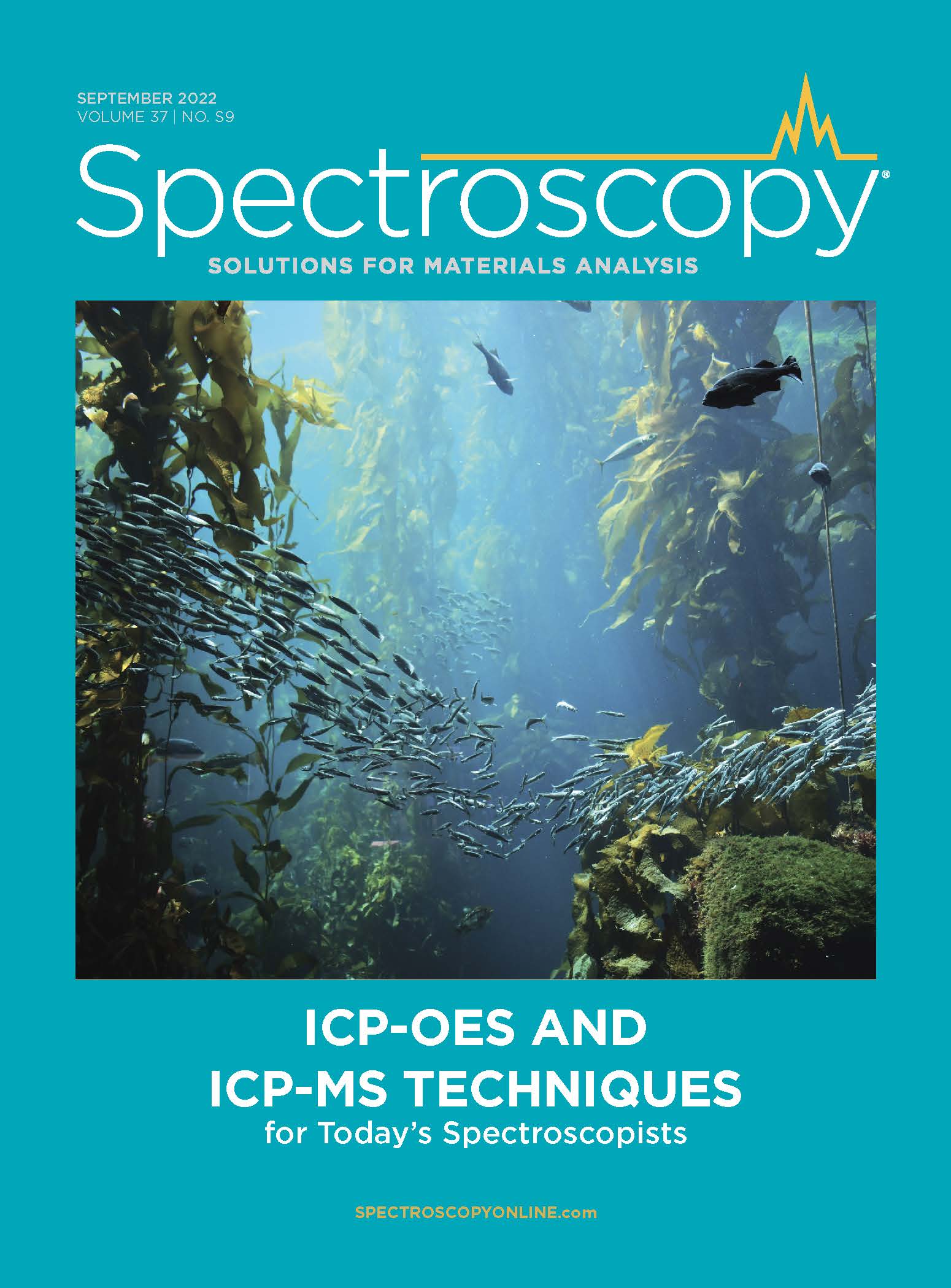Analysis of Trace Elements as Impurities in Materials Used for Lithium-Ion Battery Production
The continuous development of lithium-ion battery technology is a key step in moving away from the combustion of fossil fuels at point of use. Lithium-based batteries are the most promising alternative because they combine high capacity and good cycle stability while being moderately inexpensive. To achieve the intended performance and test for purity of the raw materials used, including cathode materials (like binary or ternary alloys containing lithium, cobalt, manganese and nickel) and electrolytes (lithium hexafluorophosphate) is highly important. For analyzing trace elements at the required levels, techniques based on inductively coupled plasmas (ICP) are the ideal choice, especially ICP–optical emission spectroscopy (ICP-OES) and also increasingly ICP–mass spectrometry (ICP-MS).
The fast market adoption of electric vehicles requires the development of analytical methods that ensure the consistent performance and safety of batteries as one of the crucial components. For production facilities, especially in the ramp-up phase, regular and rigorous quality control (QC) of all the components, including the lithium salt, anode and cathode material, and the electrolyte, of a lithium-ion battery is therefore needed. It is paramount to control impurities to avoid premature capacity loss or even failure, which could have severe consequences to the vehicle and the driver. Two typical sample types, both of high importance for the industry, are presented in this article, the analysis of brines and the analysis of electrolytes.
The large amounts of lithium required for the production of batteries is currently being explored predominantly from underground brine repositories (1). Knowing the lithium content and the amount of impurities present in the brine are important in defining the right steps to extract and purify the lithium contained. Underground brine reserves are also rich sources of lithium, in addition to mineral sources, such as spodumene ore. The abundance of lithium in brine solutions can vary significantly in the con- centration range of 10–4000 mg/L and possibly exceed that depending on the geography of the source.
A typical electrolyte that is used in current lithium-powered batteries is a mixture of different linear organic carbonates, such as diethyl carbonate (DEC) and ethyl-methyl carbonate (EMC), with lithium hexafluorophosphate (LiPF6) (2). The electrolyte plays an important role in the charging and discharging performance of the battery; hence, it needs to be checked for potential impurities. At the same time, the electrolyte is also a sample type that allows the investigation of aging processes because degradation products from all components of the battery can accumulate within it over time. Finally, once the battery is at the end of its life, all components must be thoroughly screened to ensure that potential environmental contamination and injury risks to personnel disassembling the batteries are minimized.
Both of the aforementioned sample types present specific challenges when it comes to the analysis of elemental impurities, which can be uniquely addressed when using ICP-OES. Brine solutions (typically containing percent levels of mostly sodium chloride) can cause issues with the sample introduction system, such as clogging the nebulizer or the injector tube. However, when the sample introduction system is configured accordingly, samples containing up to several percent of total dissolved solids (TDS) can be analyzed with high sensitivity and accuracy. The typical samples that need to be analyzed for composition and failure analysis of battery electrolytes would typically contain elevated amounts of organic solvents (as highlighted in this article), as well as hydrofluoric acid, derived after the partial hydrolysis of LiPF6. Here, the standard components of the sample introduction system, commonly made from high purity quartz, will need to be replaced with hydrogen fluoride (HF)-resistant replacements.
Experimental
An iCAP PRO XP inductively coupled plasma–optical emission spectroscopy (ICP-OES) Duo instrument was used in this study to carry out all measurements. The instrument was operated using intelligent full range (or iFR) mode, allowing a complete screening of the ultraviolet (UV) as well as the visible part of the spectrum in one single exposure. Because of the sensitivity requirement, the plasma was observed axially for analyzing the electrolyte solutions, whereas lithium was measured using the radial viewing mode. Analyzing samples containing highly dissolved solids is often a challenge for ICP-OES instruments, and particularly so for dual-view systems, because of problems such as salting up (leading to a blocked nebulizer or torch injector) and sample deposition on optical components (leading to signal drift and the need for increased instrument maintenance). To account for the high salt loads when analyzing brine solutions, the instrument was equipped with a ceramic torch and a Burgener Mira Mist nebulizer. To prevent salting up of the torch injector, an additional flow of argon gas was introduced at a flow rate of 0.15 L/min around the sample aerosol with the help of a sheath gas adaptor.
The instrument configuration and the operating parameters used for both sample types are summarized in Table I.
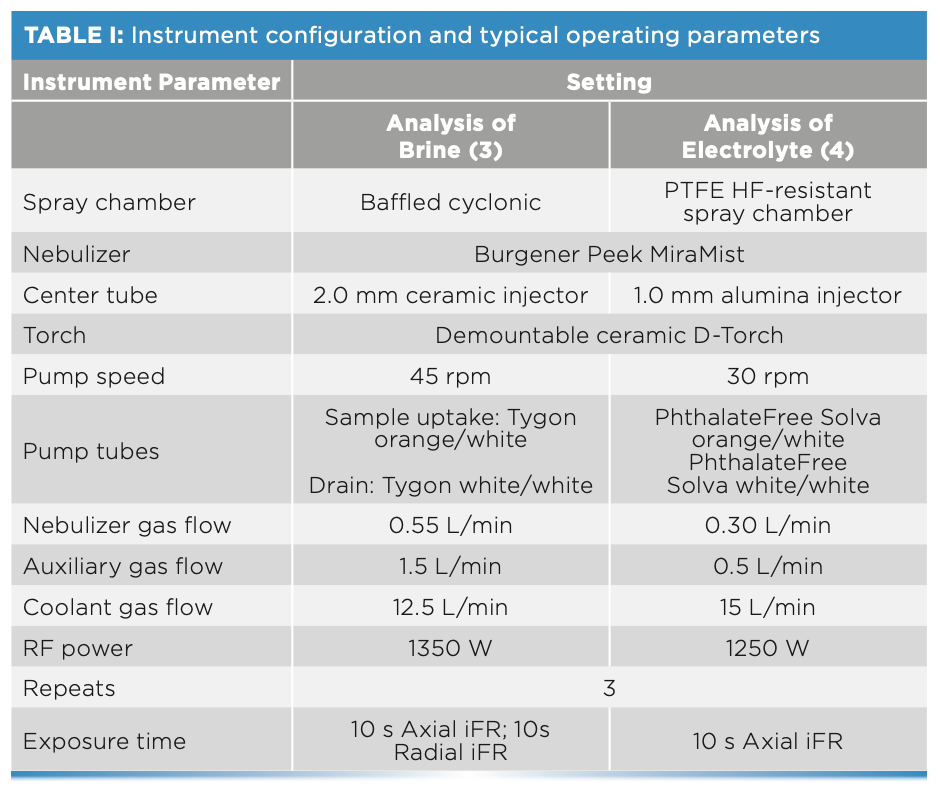
The brine samples used in this study were prepared using commercially available sodium chloride salt. To simulate the typical matrix of brine solutions, a 25% (w/w) solution of sodium chloride was prepared by dissolving 25 g of salt in 100 g of distilled water. All samples were then acidified at 0.5% (v/v) using nitric acid prior to analysis. To reduce the matrix impact, matrix-matched calibration standards were prepared. A mixed stock solution of 10 mg/L of the trace level analytes was prepared in 2% (v/v) nitric acid, which was then gravimetrically diluted to yield calibration standards in the desired concentration range between 10 and 1000 μg/L. In addition, a matrix-matched calibration curve was generated for lithium, covering a range between 10 and 5000 mg/L.
In addition to the brine samples, three different electrolyte samples were measured in this exercise. These were fresh unused LiPF6 electrolyte solutions in organic solvent mixtures like EC + EMC and EC + DEC. Approximately 2.5 g (~2 mL) of electrolyte samples were accurately diluted in 50 mL of an organic diluent consisting of 5% (v/v) EMC and 20% (v/v) ethanol in 18 MΩ·cm ultrapure water. A calibration blank and a set of calibration and linearity standards in a similar concentration range as for the brine samples were prepared using single element standards of individual analytes in the same diluent as for the samples.
Results
Table II provides an overview on the selected wavelengths for both sample types as well as the obtained correlation coefficients (R2) and resulting method detection limits (MDL). As can be seen, the wavelength selection had to be modified for some elements because of potential interferences caused by the sample matrix, but overall, good linearity and MDLs in the low mg/L concentration range were generally achieved for both sample types.
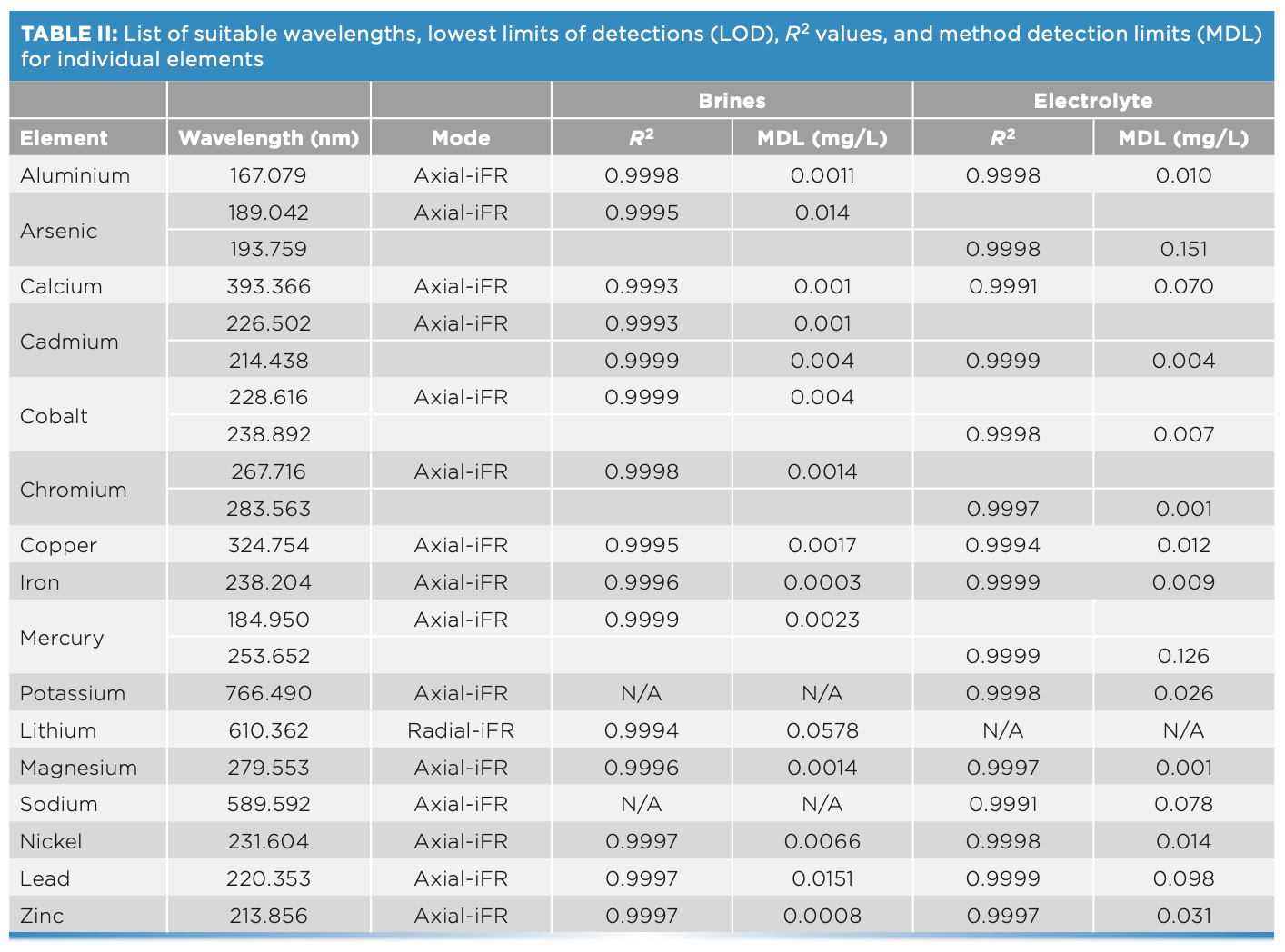
Electrolyte Analysis
The accuracy and precision of the method was assessed by monitoring the concentration recoveries of two fresh electrolyte samples spiked with 50 μg/L of the target elements. Recoveries were found to be within the accepted range of 80–120%, with most elements showing >90% (Table III). A recovery of the internal standard (5 mg/L yttrium) of approximately 90% in fresh electrolyte sample matrices demonstrated low matrix suppression, further ensuring data accuracy.

Brine Analysis
To verify whether accurate lithium measurements were possible over a wider range of concentrations, lithium was spiked into unknown brine samples at both low and high concentration levels (here, 10 mg/L, 100 mg/L, and 3000 mg/L), and the percent recovery was calculated. The accuracy of the entire analytical setup was assessed by measuring an independently prepared QC sample containing 3000 mg/L of lithium. The QC sample was analyzed every 10 samples throughout the entire analytical run of 11 h. Accurate measurement of lithium at lower concentrations in brines is as important as being able to measure high lithium concentrations because the ability to achieve lower level detection is vital for ensuring that efficient lithium extraction has been achieved after processing the brine solutions. Extraction efficiency can be easily assessed by analyzing the original brine solution after the extraction process. Table IV shows the spiked concentrations and percent recovery observed for lithium in this additional study. The recovery presented was the average value calculated from six replicate measurements of samples spiked at 10 mg/L and 100 m/L analyzed at different intervals over the duration of the analytical run. The recovery presented for 3000 mg/L of lithium-spiked concentration was the average of 18 replicate measurements. The observed average recovery for lithium in each spiked solution was found to be in the range of 100±5% with a relative standard deviation of approximately less than 5%.
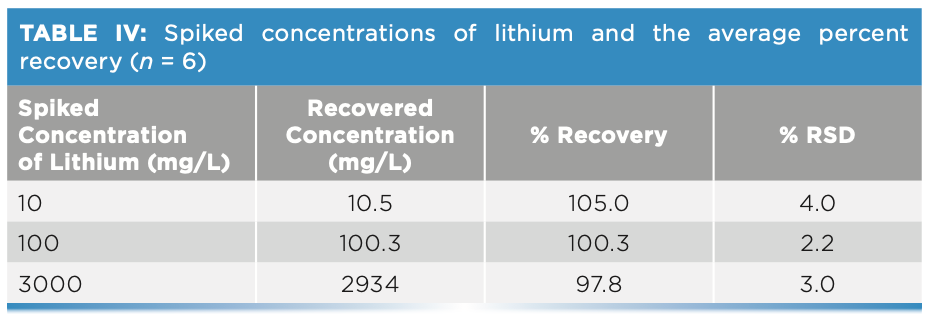
To evaluate the robustness for both sample types, the response of the internal standard (yttrium) was monitored during the measurement of a longer batch containing 135 samples (for electrolytes) and more than 200 samples (for brine), taking 7 h and 11 h to complete, respectively. The response is shown in Figure 1.
FIGURE 1: Internal standard response during (a) the analysis of brine solutions and (b) electrolytes over 11 and 7 h, respectively.
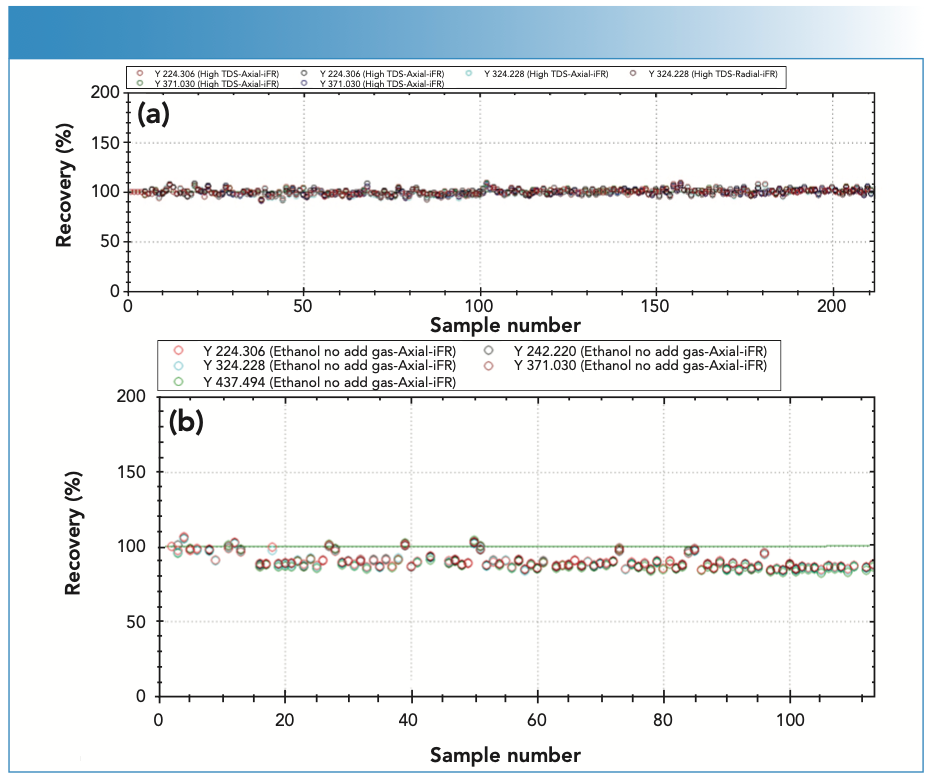
Conclusions
ICP-OES is a perfect tool for laboratories supporting the sourcing of raw materials or finished products for the manufacturing of lithium ion batteries. Typical samples, such as brines or electrolytes, expose specific challenges to the instrument. However, with the right configuration of the sample introduction system and optimized method settings (that is, wavelength selection), accurate and precise results can be obtained even for sequences exceeding typical working days of the laboratory personnel.
References and Further Reading
(1) S. Murodjon, X. Yu, M. Li, J. Duo, and T. Deng, in Thermodynamics and Energy Engineering, P. Vizureanu, Ed. (IntechOpen, London, United Kingdom, 2020), ch. 10, pp. 1–39.
(2) G. Pistoia, Ed., Lithium Batteries — New Materials, Developments, and Perspectives (Elsevier Science, Amsterdam, The Netherlands, 1994).
(3) Thermo Fisher Scientific Application Note AN 000602, Determination of Lithium and Other Elements in Brine Solutions Using ICP-OES (2022).
(4) Thermo Fisher Scientific Application Note AN 000243, Robust and Sensitive Measurement of Trace Element Impurities in LiPF6 Electrolyte Solutions Using ICP-OES (2022).
Sukanya Sengupta, Bhagyesh Surekar, and Daniel Kutscher are with Thermo Fisher Scientific, in Bremen, Germany. Simon Nelms is with Thermo Fisher Scientific, in Hemel Hempstead, United Kingdom. Direct correspondence to: daniel.kutscher@thermofisher.com ●
Trending on Spectroscopy: The Top Content of 2024
December 30th 2024In 2024, we launched multiple content series, covered major conferences, presented two awards, and continued our monthly Analytically Speaking episodes. Below, you'll find a selection of the most popular content from Spectroscopy over the past year.
Best of the Week: Hyperspectral Imaging, ICP-MS Analysis of Geological Samples, Product Roundup
October 18th 2024Top articles published this week include an article about hyperspectral imaging in human skin research, a peer-reviewed article about analyzing geological samples using atomic spectroscopy techniques, and an equipment roundup piece about the latest products in the industry.
